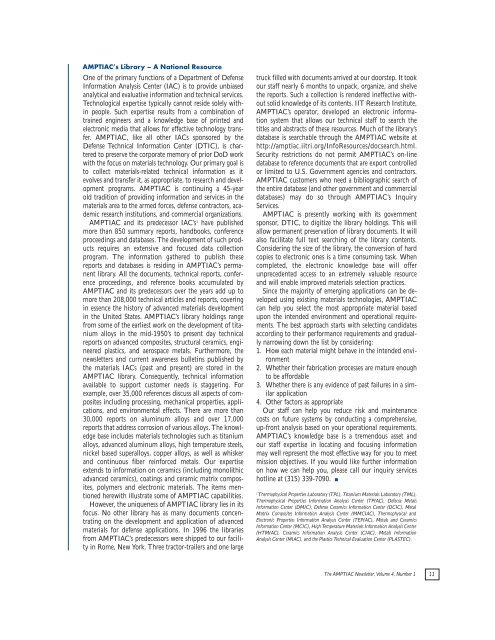AMPTIAC - Advanced Materials, Manufacturing and Testing ...
AMPTIAC - Advanced Materials, Manufacturing and Testing ...
AMPTIAC - Advanced Materials, Manufacturing and Testing ...
You also want an ePaper? Increase the reach of your titles
YUMPU automatically turns print PDFs into web optimized ePapers that Google loves.
<strong>AMPTIAC</strong>’s Library – A National ResourceOne of the primary functions of a Department of DefenseInformation Analysis Center (IAC) is to provide unbiasedanalytical <strong>and</strong> evaluative information <strong>and</strong> technical services.Technological expertise typically cannot reside solely withinpeople. Such expertise results from a combination oftrained engineers <strong>and</strong> a knowledge base of printed <strong>and</strong>electronic media that allows for effective technology transfer.<strong>AMPTIAC</strong>, like all other IACs sponsored by theDefense Technical Information Center (DTIC), is charteredto preserve the corporate memory of prior DoD workwith the focus on materials technology. Our primary goal isto collect materials-related technical information as itevolves <strong>and</strong> transfer it, as appropriate, to research <strong>and</strong> developmentprograms. <strong>AMPTIAC</strong> is continuing a 45-yearold tradition of providing information <strong>and</strong> services in thematerials area to the armed forces, defense contractors, academicresearch institutions, <strong>and</strong> commercial organizations.<strong>AMPTIAC</strong> <strong>and</strong> its predecessor IAC’s 1 have publishedmore than 850 summary reports, h<strong>and</strong>books, conferenceproceedings <strong>and</strong> databases. The development of such productsrequires an extensive <strong>and</strong> focused data collectionprogram. The information gathered to publish thesereports <strong>and</strong> databases is residing in <strong>AMPTIAC</strong>’s permanentlibrary. All the documents, technical reports, conferenceproceedings, <strong>and</strong> reference books accumulated by<strong>AMPTIAC</strong> <strong>and</strong> its predecessors over the years add up tomore than 208,000 technical articles <strong>and</strong> reports, coveringin essence the history of advanced materials developmentin the United States. <strong>AMPTIAC</strong>’s library holdings rangefrom some of the earliest work on the development of titaniumalloys in the mid-1950’s to present day technicalreports on advanced composites, structural ceramics, engineeredplastics, <strong>and</strong> aerospace metals. Furthermore, thenewsletters <strong>and</strong> current awareness bulletins published bythe materials IACs (past <strong>and</strong> present) are stored in the<strong>AMPTIAC</strong> library. Consequently, technical informationavailable to support customer needs is staggering. Forexample, over 35,000 references discuss all aspects of compositesincluding processing, mechanical properties, applications,<strong>and</strong> environmental effects. There are more than30,000 reports on aluminum alloys <strong>and</strong> over 17,000reports that address corrosion of various alloys. The knowledgebase includes materials technologies such as titaniumalloys, advanced aluminum alloys, high temperature steels,nickel based superalloys, copper alloys, as well as whisker<strong>and</strong> continuous fiber reinforced metals. Our expertiseextends to information on ceramics (including monolithicadvanced ceramics), coatings <strong>and</strong> ceramic matrix composites,polymers <strong>and</strong> electronic materials. The items mentionedherewith illustrate some of <strong>AMPTIAC</strong> capabilities.However, the uniqueness of <strong>AMPTIAC</strong> library lies in itsfocus. No other library has as many documents concentratingon the development <strong>and</strong> application of advancedmaterials for defense applications. In 1996 the librariesfrom <strong>AMPTIAC</strong>’s predecessors were shipped to our facilityin Rome, New York. Three tractor-trailers <strong>and</strong> one largetruck filled with documents arrived at our doorstep. It tookour staff nearly 6 months to unpack, organize, <strong>and</strong> shelvethe reports. Such a collection is rendered ineffective withoutsolid knowledge of its contents. IIT Research Institute,<strong>AMPTIAC</strong>’s operator, developed an electronic informationsystem that allows our technical staff to search thetitles <strong>and</strong> abstracts of these resources. Much of the library’sdatabase is searchable through the <strong>AMPTIAC</strong> website athttp://amptiac.iitri.org/InfoResources/docsearch.html.Security restrictions do not permit <strong>AMPTIAC</strong>’s on-linedatabase to reference documents that are export controlledor limited to U.S. Government agencies <strong>and</strong> contractors.<strong>AMPTIAC</strong> customers who need a bibliographic search ofthe entire database (<strong>and</strong> other government <strong>and</strong> commercialdatabases) may do so through <strong>AMPTIAC</strong>’s InquiryServices.<strong>AMPTIAC</strong> is presently working with its governmentsponsor, DTIC, to digitize the library holdings. This willallow permanent preservation of library documents. It willalso facilitate full text searching of the library contents.Considering the size of the library, the conversion of hardcopies to electronic ones is a time consuming task. Whencompleted, the electronic knowledge base will offerunprecedented access to an extremely valuable resource<strong>and</strong> will enable improved materials selection practices.Since the majority of emerging applications can be developedusing existing materials technologies, <strong>AMPTIAC</strong>can help you select the most appropriate material basedupon the intended environment <strong>and</strong> operational requirements.The best approach starts with selecting c<strong>and</strong>idatesaccording to their performance requirements <strong>and</strong> graduallynarrowing down the list by considering:1. How each material might behave in the intended environment2. Whether their fabrication processes are mature enoughto be affordable3. Whether there is any evidence of past failures in a similarapplication4. Other factors as appropriateOur staff can help you reduce risk <strong>and</strong> maintenancecosts on future systems by conducting a comprehensive,up-front analysis based on your operational requirements.<strong>AMPTIAC</strong>’s knowledge base is a tremendous asset <strong>and</strong>our staff expertise in locating <strong>and</strong> focusing informationmay well represent the most effective way for you to meetmission objectives. If you would like further informationon how we can help you, please call our inquiry serviceshotline at (315) 339-7090. ■1Thermophysical Properties Laboratory (TPL), Titanium <strong>Materials</strong> Laboratory (TML),Thermophysical Properties Information Analysis Center (TPIAC), Defense MetalsInformation Center (DMIC), Defense Ceramics Information Center (DCIC), MetalMatrix Composites Information Analysis Center (MMCIAC), Thermophysical <strong>and</strong>Electronic Properties Information Analysis Center (TEPIAC), Metals <strong>and</strong> CeramicsInformation Center (MCIC), High Temperature <strong>Materials</strong> Information Analysis Center(HTMIAC), Ceramics Information Analysis Center (CIAC), Metals InformationAnalysis Center (MIAC), <strong>and</strong> the Plastics Technical Evaluation Center (PLASTEC).The <strong>AMPTIAC</strong> Newsletter, Volume 4, Number 1 11
















